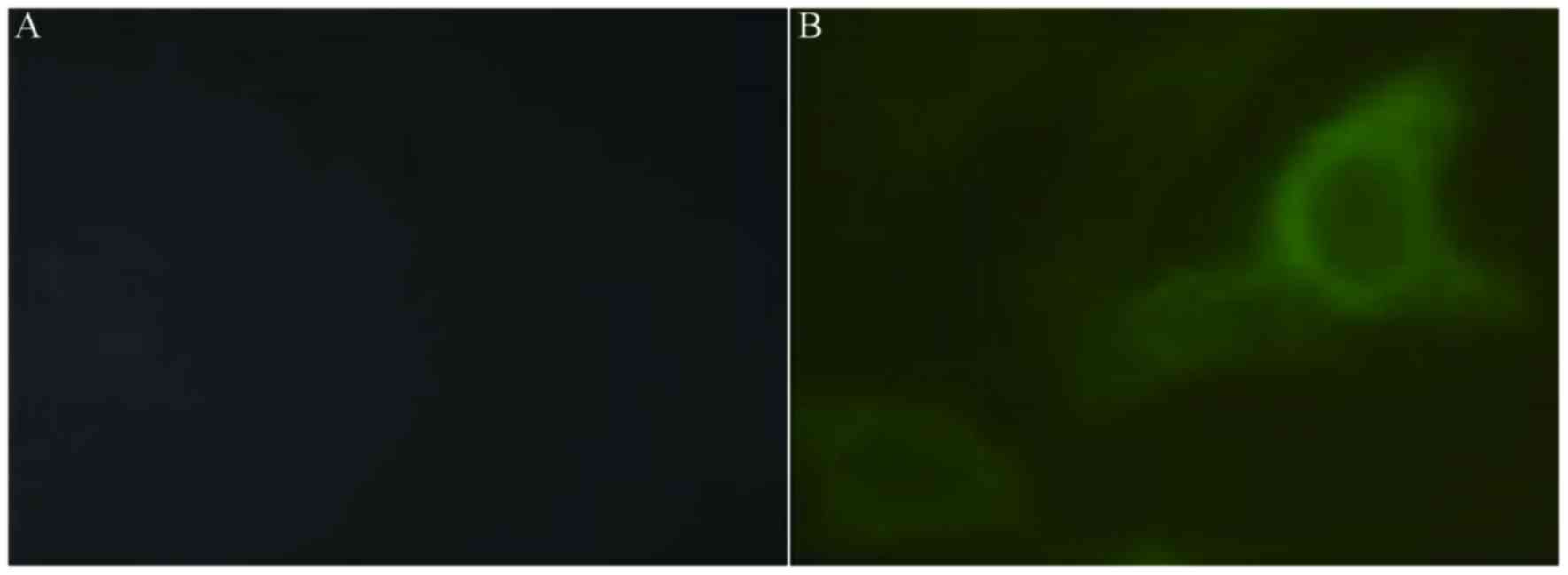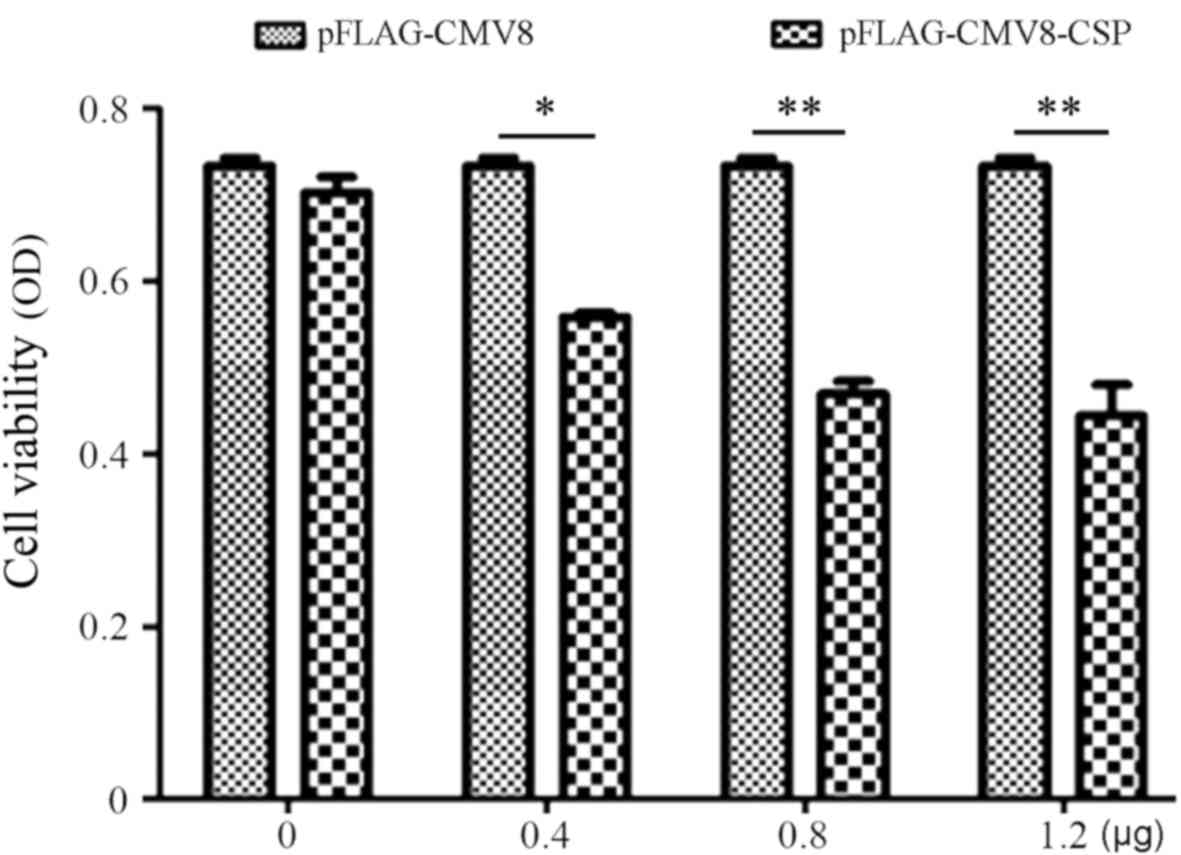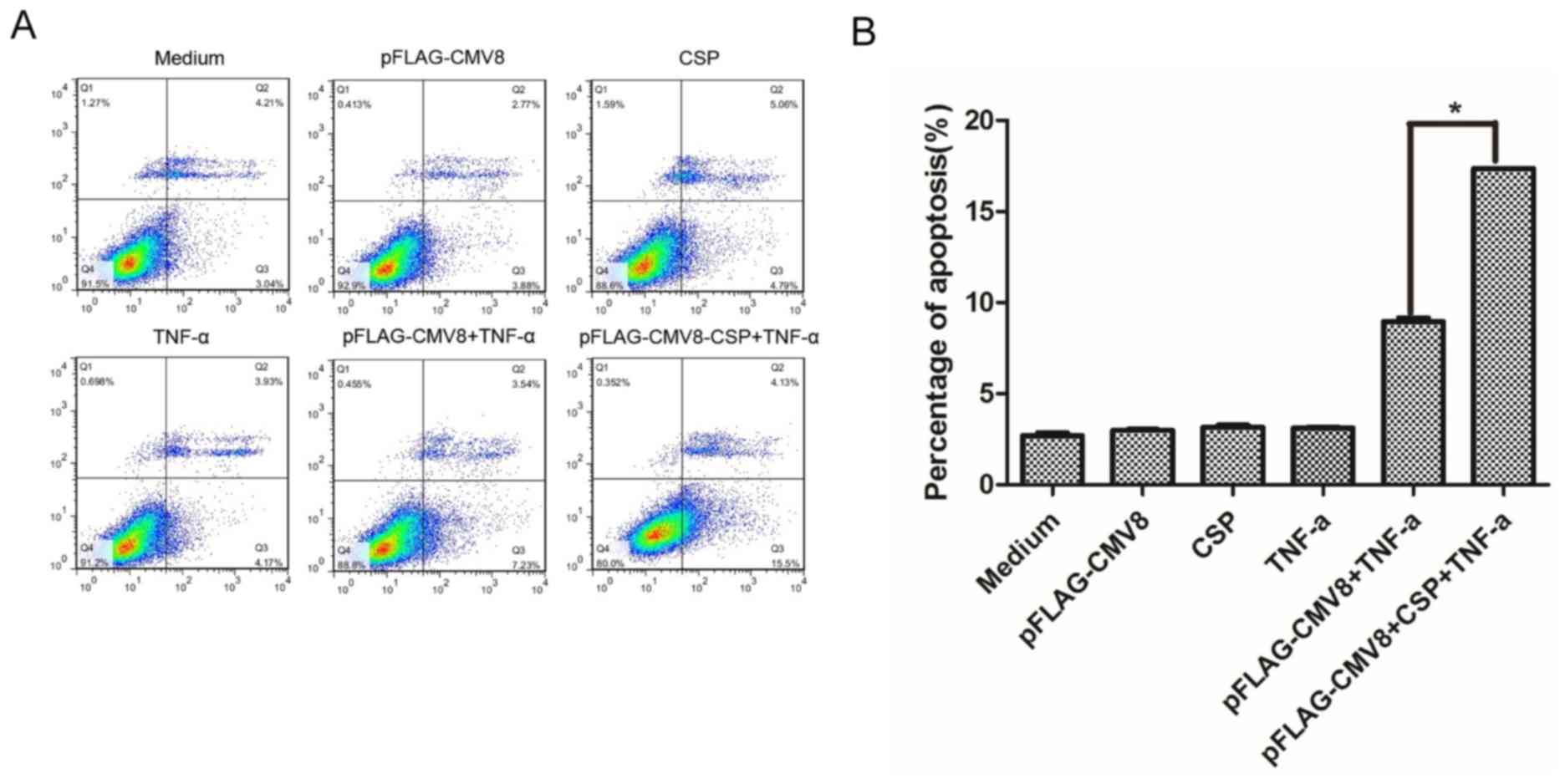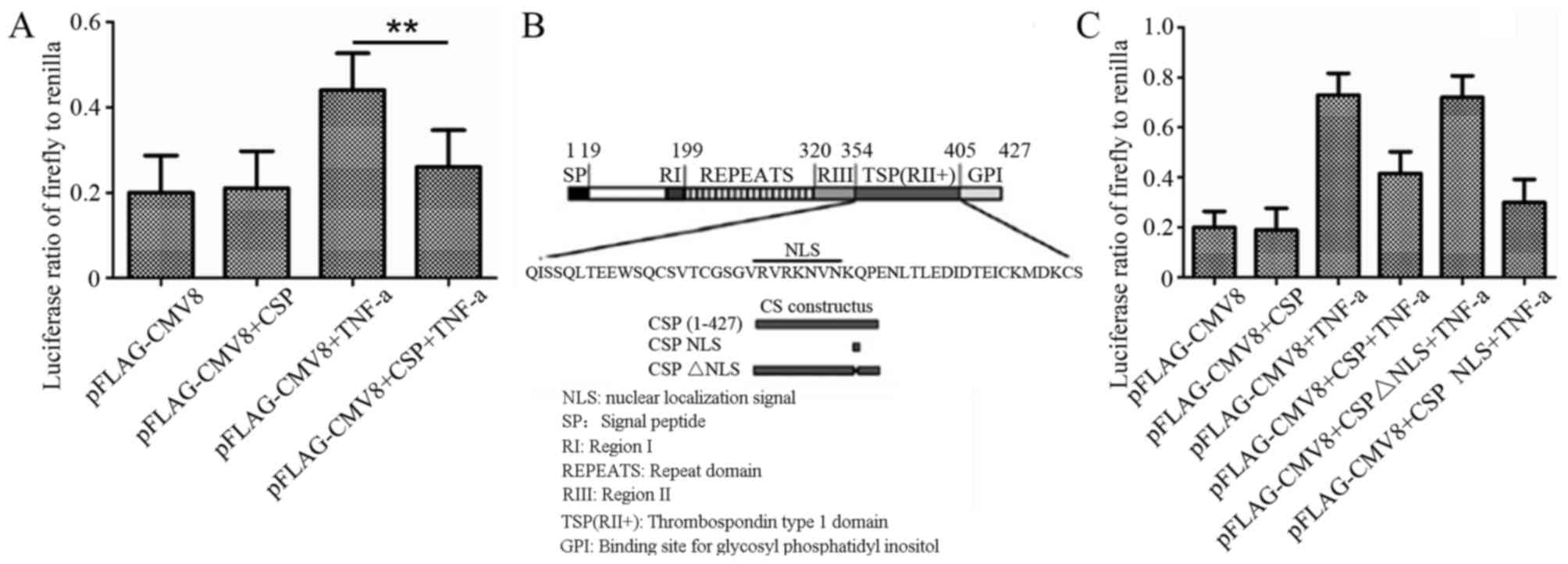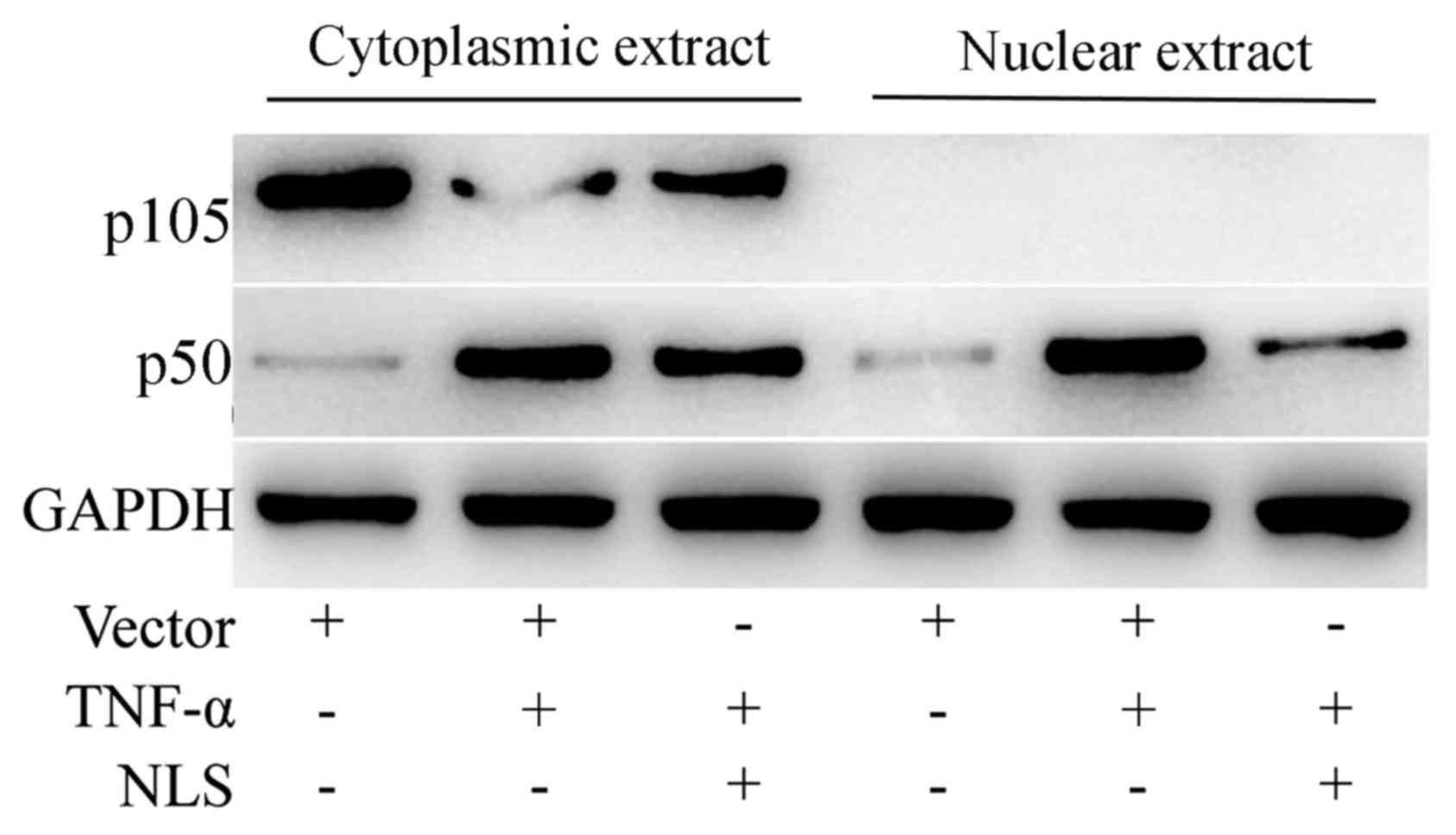Plasmodium circumsporozoite protein suppresses the growth of A549 cells via inhibiting nuclear transcription factor κB
- Authors:
- Published online on: February 26, 2018 https://doi.org/10.3892/ol.2018.8115
- Pages: 6585-6591
Abstract
Introduction
Lung cancer remains the leading cause of cancer-associated mortality, and accounted for 19.4% of the total number of cancer mortalities worldwide in 2012 (1). Non-small cell lung carcinoma (NSCLC) accounts for ~85% of diagnosed lung cancer cases and is associated with an overall 5-year survival rate of <20% (2). Despite advances in the diagnosis and treatment of patients with NSCLC, the majority of patients with succumb to the disease. Therefore, there is an urgent requirement to develop more effective therapies for patients with this neoplasm.
Nuclear factor κB (NF-κB) is a family of inducible transcription factors that exert a variety of evolutionarily conserved roles in the immune system (3,4). NF-κB is able to induce rapid transcription of genes regulating inflammation, cell survival, proliferation and differentiation (5,6). The NF-κB family consists of five related proteins, p50 (NF-κB1) and p52 (NF-κB2), p65 (RelA), RelB and c-Rel (Rel), which exist in unstimulated cells as homo- or heterodimers bound to IκB family proteins in the cytoplasm. Following stimulation by pro-inflammatory cytokines, including tumor necrosis factor-α (TNF-α) or lipopolysaccharide (LPS), the phosphorylated IκB kinase (IKK) degrades the inhibitory protein IκB, and releases NF-κB. NF-κB (p50/p65 or p52/Rel-B) then translocates into the nucleus and results in the activation of target genes, including cytokines, chemokines and antiapoptotic genes (7).
The association of NF-κB with tumorigenesis is well documented in both colitis-associated and hepatitis-associated cancer models (8,9). The constitutive activation of NF-κB in cancer cells was demonstrated to result in anti-apoptosis, cell growth, angiogenesis and metastasis of tumor cells (10–15). By contrast, blocking NF-κB activation prevents inflammation-mediated tumor growth and metastasis (16,17). Therefore, NF-κB is an innovative target for antitumor therapy.
The circumsporozoite protein (CSP) is the main surface protein of sporozoite of the malaria parasite. Previously, it was shown that the transfer of the CSP from the parasitophorous vacuole to the cytoplasm is essential for the development of the malaria parasite in the hepatocytes, due to its ability to block NF-κB activation in hepatocytes (18). Therefore, the effect of CSP on the growth of the human Lung cell line, A549, was investigated and the results indicated that CSP, via its NLS motif, was able to suppress the proliferation and survival of A549 through competition with the nuclear translocation of NF-κB.
Materials and methods
Recombinant plasmid construction
Total RNA of 5×106 Plasmodium yoelii 265BY sporozoite (gifted from the Academy of Military Medical Sciences of China, Beijing, China) was extracted using TRIzol™ Reagent (Thermo Fisher Scientific, MA, USA) and reverse transcribed to cDNA using PrimeScript™ RT reagent kit with gDNA Eraser (Takara Bio, Inc., Otsu, Japan). The full-length CSP coding sequence was amplified using polymerase chain reaction (PCR) from the cDNA with the primers PCSP3 (5′-CCCaagcttGGGAAGAAGTGTACCATTTTAG-3; the Hind III restriction site is underlined) and PCSP1284 (5′-CGggatccCGTTAATTAAAGAATACTAATAC-3′, the BamH I restriction site is underlined). The amplified fragment, which was 1281 bp in length, was cloned into the pFLAG-CMV8 plasmid, resulting in the recombinant plasmid pFLAG-CMV8-CSP. The PCR conditions consisted of an initial predenature at 94°C for 2 min, denaturation at 98°C for 10 sec, annealing at 50°C for 30 sec followed by amplification for 40 cycles of 45 sec at 68°C. A second plasmid, pFLAGCMV8-CSP NLS, was constructed through ligation of the annealing nuclear location signal (NLS) oligonucleotide to the Hind III and BamH I restriction sites of pFLAG-CMV8. To construct the recombinant plasmid pFLAG-CMV8-CSPΔNLS, the CSP lacking the NLS was obtained by overlapping PCR using a KOD FX kit (Toyobo Life Science, Osaka, Japan) and then cloned into the Hind III and BamH I restriction sites of pFLAG-CMV8. Two fragments of CSP without NLS were amplified from the full CSP coding sequence (1284 bp). The primer sequences used are as follows: first fragment (1–1119 bp), forward, 3′-AAGCTTGGGAAGAAGTGTACCATTTTAGTTG-5′, and reverse, 3′-TTCTGGTTGCTTGTTACCAGAACCACAGGTTAC-5′, and second fragment (1147–1284 bp), forward, 3′-AACAAGCAACCAGAAAATTTGACCTTAGAGG-5′, and reverse, 3′-GGATCCTTAATTAAAGAATACTAATACTAATAATATTAC-5′.
The PCR conditions for the two fragments consisted of pre-denaturation at 94°C for 3 min; 35 cycles of denaturation at 94°C for 30 sec, annealing at 50° for 30 sec and extension at 68°C for 90 sec, followed by a final extension at 68°C for 5 min. The two fragments were purified using a Gel Extraction Kit (Omega Bio-Tek, Inc., Norcross, GA, USA). The splicing CSPΔNLS (1257 bp) fragment was amplified using the following primers: forward, 5′-CTGTGGTTCTGGTAACAAGCAACCAG-3′ and reverse, 5′-CTGGTTGCTTGTTACCAGAACCACAG-3′. The overlapping PCR conditions consisted of an initial pre-denaturation at 94°C for 3 min; 35 cycles of denaturation at 94°C for 30 sec, annealing at 42° for 30 sec and extension at 68°C for 90 sec, followed by a final extension at 68°C for 5 min. The correct orientation of all the recombinant plasmids was confirmed using DNA sequencing.
Cell culture
A549 cell line was purchased from the Japanese Cancer Research Bank (JCRB, Tokyo, Japan). A549 cells were maintained in 10% fetal bovine serum (Gibco; Thermo Fisher Scientific, Inc.) supplemented Dulbecco's modified Eagle's medium (Nacalai Tesque, Kyoto, Japan), 100 U/ml penicillin and 100 µg/ml streptomycin. The culture conditions were at 37°C with a 5% CO2 atmosphere and 85% humidity were achieved by adjusting the incubator (ASTEC, Fukuoka, Japan).
Preparation of rabbit anti-CSP serum
The B cell epitope QGP GAQ GPG AQG PGA P of the CSP was synthesized and purified via high-performance liquid chromatography (HPLC) by using Shimadzu Inertsil ODS-SP column (4.6×250 mm ×5 µm; Shimadzu Corporation) on a Shimadzu Corporation Prominence HPLC system (Kyoto, Japan). The column was operated at 30°C, and proteins were detected at 214 nm. Samples were analyzed at a volume of 60 µl. The composition of mobile phase (two solvents) was as follows: buffer A: 0.1% TFA (A501480, Sangon Biotech, China) in 100% water and buffer B: 0.1% TFA in 100% acetonitrile (A506811, Sangon Biotech, China). The flow rate was 1.0 ml/min, and the gradient elution condition was as follows: the running time was 27.01 min, the initial mobile phase was consist of 92% buffer A and 8% buffer B, and the final mobile phase was consist of 5% buffer A and 95% buffer B. The consist of mobile phase was changed by the system with time in the gradient elution.
Then the peptide was conjugated with keyhole limpet hemocyanin (KLH). The peptide was produced by Beijing Biosynthesis Biotechnology Co., Ltd., (Beijing, China; cat. no., 080825). The resulting conjugated peptide was emulsified with Freund's adjuvant (Sigma-Aldrich; Merck KGaA, Darmstadt, Germany) and immunized in a specific-pathogen-free grade rabbit at 0, 2 and 4 weeks. After the final immunization, rabbit serum was collected, and the titer of antibody against the epitope was detected using ELISA (cat. no., 44-2404-21, Nunc MaxiSorp™ flat-bottom, Nalge Nunc International, Penfield, NY, USA). Ethical approval for animal experiments was obtained from the Animal Ethical and Welfare Committee of The Third Military Medical University (Chongqing, China).
Indirect immunofluorescence assay (IFA)
Following transfection with 0.8 µg pFLAG-CMV8-CSP or a control plasmid using Lipofectamine 2000TM for 24 h, A549 cells, which were grown on a coverslip in 24-well plate, were incubated with rabbit anti-CSP serum (1:10) for 1 h. After two washes with phosphate-buffered saline (PBS), the cells were labeled with goat anti-rabbit FITC-immunoglobulin G (H+L) for 20 min and observed under fluorescence microscopy.
Alamar Blue assay
Alamar blue is a sensitive oxidation reduction indicator that fluoresces and undergoes a color change upon reduction in living cells. A549 cells were transfected with or without pFLAG-CMV8-CSP (0.2, 0.4, 0.8, 1.2 or 1.6 µg), and after 24 h 120 µl SunBioTMAm-Blue was added to each well and incubated for 2 h at 37°C. The fluorescence was read at 570 and 600 nm. Cell proliferation was expressed as optical density (OD) ratio of OD570/OD600.
Dual luciferase assay
A549 cells were transfected using Lipofectamine™ 2000 in 24-well plates. Each well received 200 ng pBIIx-luc report vector containing two κB sites upstream of the c-fos promoter (gift from Dr Sankar Ghosh, Yale University, Connecticut, USA) and 2 ng TK-RL (Promega Corporation, Madison, WI, USA), together with 600 ng Pflag-CMV8-CSP, pFLAG-CMV8-CSP NLS or pFLAG-CMV8-CSPΔNSL. After 24 h, the cells were stimulated in the presence or absence of 100 ng/ml human recombinant TNF-α (hTNF-α; PeproTech, New Jersey, USA) and/or lipopolysaccharide (Invitrogen; Thermo Fisher Scientific, Inc.) for 6 h. Next, the cells were lysed, and the activity of firefly and Renilla luciferase was determined using the Dual Luciferase Assay kit (Promega Corporation). The data were expressed as the ratio of firefly luciferase to Renilla luciferase.
Annexin V-fluorescein isothiocyanate (FITC) apoptosis assay
After A549 cells were transfected with or without 0.8 µg pFLAG-CMV8-CSP for 24 h, the cells were stimulated with 100 ng/ml hTNF-α for 6 h. Next, the cells were collected and incubated with Annexin V-FITC (Beyotime Institute of Biotechnology, Haimen, China) and propidium iodide (PI) for 10 min on ice and analyzed using flow cytometry. The data were analyzed by FlowJo software 10.4 (FlowJo LLC, Ashland, OR, USA).
Western blotting
Following transfection with or without 4 µg pFLAG-CMV8-CSP NLS for 24 h, A549 cells were re-stimulated with 100 ng/ml hTNF-α for 30 min. The cells (2×106) were washed with cold PBS and suspended in 0.4 ml hypotonic lysis buffer containing protease inhibitors for 30 min. The cells were lysed with 12.5 µl 10% Nonidet P-40 (Beyotime Institute of Biotechnology). The homogenate was centrifuged, and the supernatant containing the cytoplasmic extracts was stored at −80°C. The nuclear pellet was resuspended in 25 µl ice-cold nuclear extraction buffer. After 30 min of intermittent mixing, the extract was centrifuged at 15,000 × g for 30 min, and the supernatants containing nuclear extracts were collected. Protein concentration in cytoplasmic extracts and nuclear extracts were then determined with the BCA protein assay kit (Beyotime Institute of Biotechnology). Equal amounts 20 µg of cytoplasmic and nuclear extracts were separated using SDS-PAGE (10% gel), transferred to a PVDF membrane, then washed by TBST buffer (TBS buffer with 0.1% tween-20) and blocked by 5% non-fat-dried milk in TBST buffer at room temperature for 1 h. After blocking, the membrane was probed with primary antibodies against NF-κB p105/p50 (1:2,000; cat. no., 12540; Cell Signaling Technology, Inc., Danvers, MA, USA) and GAPDH (1:4,000; cat. no., 5174; Cell Signaling Technology, Inc.) for 16 h at 4°C, and secondary goat anti-rabbit HRP-conjugated antibody (1:20,000; cat. no., sc-2004; Santa Cruz Biotechnology, Inc., Dallas, TX, USA) for 1 h at room temperature, then the bands were detected by using ECL reagent (Pierce; Thermo Fisher Scientific, Inc.).
Statistical analysis
All data were analyzed using Student's t-test or one-way analysis of variance, and P<0.05 was considered statistically significant. SPSS 19.0 software (IBM Corp., Armonk, NY) was used for the statistical analysis.
Results
CSP suppresses the proliferation of A549 cells
For CSP to be able to promote the development of sporozoite in hepatocytes, it has to be transferred from the parasitophorous vacuole into the cytoplasm (18). To mimic this process, the full length of the CSP coding sequence was amplified from the Plasmodium yoelii 265BY sporozoite, and cloned into the pFLAG-CMV8 plasmid. The resulting recombinant plasmid, pFLAG-CMV8-CSP, was then transfected into the human lung cancer cell line A549, and its intracellular distribution was determined using indirect immunofluorescence assay using anti-CSP serum. CSP was expressed primarily in the cytoplasm. CSP was not present in A549 cells transfected with pFLAG-CMV8 (Fig. 1A), but was present in the membrane of A549 cells following transfection of recombinant plasmid pFLAG-CMV8-CSP (Fig. 1B).
CSP in the cytoplasm is important for the development of the malaria sporozoite (18). However, the effects of CSP on cancer cell proliferation are unclear. Thus, the Alamar Blue assay was used to investigate the effect of the CSP on proliferation of A549 cells. As shown in Fig. 2, transfection with 0.4 µg pFLAGCMV8-CSP was able to significantly suppress the proliferation of A549, compared with proliferation following transfection with the control pFLAG-CMV8. When the concentration of the transfected pFLAG-CMV8-CSP was increased from 0.4 to 1.2 µg, cell viability and proliferation decreased in a dose-dependent manner. Following transfection with 1.2 µg pFLAG-CMV8-CSP, cell proliferation was <30% (OD value, 0.105 vs. 0.375). Thus, the data demonstrated the inhibitory role of CSP on the proliferation of A549 cells.
CSP induces the apoptosis of A549 cells
To investigate whether CSP is also able to induce the apoptosis of A549 cells, an Annexin V-FITC apoptosis assay was performed following the transfection of cells with 0.8 µg pFLAG-CMV8-CSP and then stimulated with hTNF-α. As indicated in Fig. 3, the apoptotic rate of A549 cells transfected with the control plasmid pFLAG-CMV8 was 3.5%, comparable with the rate of cells that were transfected with pFLAG-CMV8 or pFLAG-CMV8-CSP, or stimulated with hTNF-α alone. However, the apoptotic rate of hTNF-α-stimulated A549 cells transfected with pFLAG-CMV8-CSP was significantly higher compared with the rate of cells that were transfected with pFLAG-CMV8 (17.4 vs. 3.5%, P<0.01). Therefore, the data indicated that CSP was able to induce the apoptosis of A549 cells.
CSP suppresses TNF-α-induced activation of NF-κB in A549 cells through its NLS domain
As NF-κB is important for survival and proliferation of tumor cells (8), the effect of the CSP on NF-κB activation in A549 cells was investigated. A NF-κB reporter gene assay indicated that transfection with pFLAG-CMV8-CSP was able to suppress the activation of NF-κB in hTNF-α-induced A549 cells (P=0.008; Fig. 4A). CSP is a critical protein for the invasion of sporozoites into hepatocytes and includes important motifs, including region I, region II+ and region III (Fig. 3B) (19). Previously, a NLS motif with a sequence of VRVRKNVN was reported in CSP (18) (Fig. 4B). To determine the region responsible for NF-κB inactivation by CSP, the recombinant plasmids pFLAGCMV8-CSP NLS (containing only the NLS motif) and pFLAG-CMV8-CSPΔNLS (CSP lacking the NLS motif) were constructed (Fig. 3B), and their inhibitory role on the activation of NF-κB in hTNF-α-induced A549 cells was observed. As shown in Fig. 4C, transfection of pFLAGCMV8-CSPΔNLS was not able to inhibit NF-κB activation in hTNF-α-stimulated A549 cells, compared with that transfected with pFLAG-CMV8 or pFLAG-CMV8-CSP. However, transfection with pFLAG-CMV8-CSP or pFLAG-CMV8-CSP NLS was able to reduce NF-κB activity of A549 cell by >3.5 fold, when compared with pFLAG-CMV8 plasmid. Therefore, the data supported the essential role of NLS for the inactivation of NF-κB by CSP.
NLS of CSP outcompetes the nuclear translocation of NF-κB in A549 cells following TNF-α induction
Proteins with NLS are imported into the cell nucleus through the nuclear pore complex (20). It was hypothesized that CSP may inhibit the nuclear translocation of NF-κB through its NLS motif. The cytoplasmic and nuclear extracts were probed with NF-κB p105/p50 antibody following separation on SDS-PAGE. As indicated in Fig. 5, although the cytoplasmic NF-κB p50 was at a comparable level in A549 cells transfected with either pFLAG-CMV8 or pFLAG-CMV-CSPNLS, the level of NF-κB p50 in the nuclear extract of A549 cells transfected with pFLAG-CMV-CSP NLS was markedly lower compared with cells transfected with pFLAG-CMV8. Therefore, the data suggested that NLS did not affect the phosphorylation of IκB, and the subsequent release of NF-κB from the inhibitory complex, but it may inhibit the nuclear translocation of the activated NF-κB.
Discussion
The aim of the present study was to determine whether CSP was able to inhibit the growth of the human cancer cell A549. The data demonstrated that CSP was observed to be primarily distributed in the cytoplasm of A549 cells following transfection, and that CSP was able to suppress the proliferation and induce the apoptosis of A549 cells. The inhibitory role of CSP on the growth of A549 cells may be dependent on whether the CSP NLS motif is able to outcompete the nuclear translocation of NF-κB.
CSP has an important role in the sporozoite invasion of hepatocytes and is regarded as an immunodominant protective antigen of irradiation-attenuated sporozoite (21). It was found that CSP was able to significantly suppress the growth of human lung cancer cell line A549 in a dose-dependent manner (Fig. 2) and induce its apoptosis (Fig. 3). It remains to be established whether antiapoptotic genes (22), including B-cell lymphoma 2, cellular FLICE-like inhibitory protein, survivin and IAP-1, are also involved in this process, and whether CSP is also able to suppress the growth of other human lung cancer cell lines. However, the present study has demonstrated a potential novel role of CSP in inhibiting the growth of tumor cells.
NF-κB activation is critical for the proliferation, survival and metastasis of cancer cells, thus it was investigated whether the inhibition of CSP on growth of A549 cells was associated with CSP-mediated blockage of NF-κB nuclear translocation. It was indicated that the transfection of pFLAG-CMV-CSP or pFLAG-CMV-CSP NLS was able to markedly reduce the activity of NF-κB, at comparable levels to the activity of hTNF-α-induced A549 cells (Fig. 3B). Furthermore, the NLS motif of the CSP, but not other sequences, inhibited the nuclear translocation of NF-κB in tumor cells (Fig. 4). Thus, the data indicated that the inhibitory role of CSP on the growth of A549 cells may be attributed to the ability of the CSP NLS motif to outcompete the nuclear translocation of NF-κB in tumor cells.
However, other mechanisms of CSP on tumor growth could not be excluded, as CSP was previously reported to modulate non-NF-κB target genes (18) and inhibit protein synthesis by binding to the ribosome (23).
Inhibition of NF-κB activation is a promising antitumor strategy (24,25). Several NF-κB inhibitors have been reported to treat various tumors. Curcumin, which inhibits at a step prior to IκB phosphorylation, may suppress the growth of human multiple myeloma cells, and head and neck squamous cell carcinoma (26,27), as well as sensitize colorectal cancer and breast cancer cells to radiation and chemotherapy (28–31). It was reported that curcumin does not specifically target tumor cells and also have a toxic effect on normal tissues, including the immune system, when administrated in vivo (26). Recently, a small molecule inhibitor of IKKβ, KINK-1, was reported to increase the susceptibility of melanoma cells to chemotherapy through specifically inhibiting the canonical pathway of NF-κB activation involved in tumor progression (32). Although KINK-1 has no unwanted side effects on adaptive immunity mediated by the non-canonical pathway, its side effects on innate immunity cannot be completely avoided (33). In the present study, a novel protein-based NF-κB inhibitor, CSP, which is a main surface protein of the malarial sporozoite, was reported to suppress the growth of A549 cells. Evidence has suggested that the specificity of gene therapy on tumor cells can be achieved by placing the therapeutic gene downstream of a tumor-specific promoter, such as hTERT (34,35). Thus, it would be possible to specifically suppress the NF-κB activation in tumor cell, but not the immune system through engineering the CSP into a vector containing a tumor-specific promoter. However, whether the design would work requires further research.
In summary, the data of the present study demonstrated that the Plasmodium yoelii BY265 CSP was able to suppress the growth of A549 human lung cancer cells, potentially via its NLS domain, which outcompetes the nuclear translocation of NF-κB. Although further investigations regarding the effects of CSP on the invasive ability of lung cancer cells as well as its antitumor efficiency in vivo are necessary, the potential ability of the CSP to act as a novel NF-κB inhibitor for the treatment of lung cancer should be investigated.
Acknowledgements
The present study was supported by funding from the General Program of National Natural Science Foundation of China (grant nos. 81172238 and 81472188). The present study was also supported by the Third Military Medical University.
References
|
Ferlay J, Soerjomataram I, Dikshit R, Eser S, Mathers C, Rebelo M, Parkin DM, Forman D and Bray F: Cancer incidence and mortality worldwide: Sources, methods and major patterns in GLOBOCAN 2012. Int J Cancer. 36:E359–E386. 2015. View Article : Google Scholar | |
|
Torre LA, Bray F, Siegel RL, Ferlay J, Lortet-Tieulent J and Jemal A: Global cancer statistics, 2012. CA Cancer J Clin. 65:87–108. 2015. View Article : Google Scholar : PubMed/NCBI | |
|
Gilmore TD and Wolenski FS: NF-κB: Where did it come from and why? Immunol Rev. 246:14–35. 2012. View Article : Google Scholar : PubMed/NCBI | |
|
Hayden MS and Ghosh S: NF-κB in immunobiology. Cell Res. 21:223–244. 2011. View Article : Google Scholar : PubMed/NCBI | |
|
Hayden MS and Ghosh S: Regulation of NF-κB by TNF family cytokines. Semin Immunol. 26:253–266. 2014. View Article : Google Scholar : PubMed/NCBI | |
|
Hayden MS and Ghosh S: Signaling to NF-kappaB. Genes Dev. 18:2195–2224. 2004. View Article : Google Scholar : PubMed/NCBI | |
|
Maeda S and Omata M: Inflammation and cancer: Role of nuclear factor-kappaB activation. Cancer Sci. 99:836–842. 2008. View Article : Google Scholar : PubMed/NCBI | |
|
Pikarsky E, Porat RM, Stein I, Abramovitch R, Amit S, Kasem S, Gutkovich-Pyest E, Urieli-Shoval S, Galun E and Ben-Neriah Y: NF-kappaB functions as a tumour promoter in inflammation-associated cancer. Nature. 431:461–466. 2004. View Article : Google Scholar : PubMed/NCBI | |
|
Greten FR, Eckmann L, Greten TF, Park JM, Li ZW, Egan LJ, Kagnoff MF and Karin M: IKKbeta links inflammation and tumorigenesis in a mouse model of colitis-associated cancer. Cell. 118:285–296. 2004. View Article : Google Scholar : PubMed/NCBI | |
|
Nakshatri H, Bhat-Nakshatri P, Martin DA, Goulet RJ Jr and Sledge GW Jr: Constitutive activation of NF-kappaB during progression of breast cancer to hormone-independent growth. Mol Cell Biol. 17:3629–3639. 1997. View Article : Google Scholar : PubMed/NCBI | |
|
Lindholm PF, Bub J, Kaul S, Shidham VB and Kajdacsy-Balla A: The role of constitutive NF-kappaB activity in PC-3 human prostate cancer cell invasive behavior. Clin Exp Metastasis. 18:471–479. 2000. View Article : Google Scholar : PubMed/NCBI | |
|
Wang W, Abbruzzese JL, Evans DB, Larry L, Cleary KR and Chiao PJ: The nuclear factor-kappa B RelA transcription factor is constitutively activated in human pancreatic adenocarcinoma cells. Clin Cancer Res. 5:119–127. 1999.PubMed/NCBI | |
|
Sakamoto K, Maeda S, Hikiba Y, Nakagawa H, Hayakawa Y, Shibata W, Yanai A, Ogura K and Omata M: Constitutive NF-kappaB activation in colorectal carcinoma plays a key role in angiogenesis, promoting tumor growth. Clin Cancer Res. 15:2248–2258. 2009. View Article : Google Scholar : PubMed/NCBI | |
|
Hagemann T, Wilson J, Kulbe H, Li NF, Leinster DA, Charles K, Klemm F, Pukrop T, Binder C and Balkwill FR: Macrophages induce invasiveness of epithelial cancer cells via NF-kappa B and JNK. J Immunol. 175:1197–1205. 2005. View Article : Google Scholar : PubMed/NCBI | |
|
Stathopoulos GT, Sherrill TP, Han W, Sadikot RT, Yull FE, Blackwell TS and Fingleton B: Host nuclear factor-kappaB activation potentiates lung cancer metastasis. Mol Cancer Res. 6:364–371. 2008. View Article : Google Scholar : PubMed/NCBI | |
|
Luo JL, Maeda S, Hsu LC, Yagita H and Karin M: Inhibition of NF-kappaB in cancer cells converts inflammation-induced tumor growth mediated by TNFalpha to TRAIL-mediated tumor regression. Cancer Cell. 6:297–305. 2004. View Article : Google Scholar : PubMed/NCBI | |
|
Yang J, Pan WH, Clawson GA and Richmond A: Systemic targeting inhibitor of kappaB kinase inhibits melanoma tumor growth. Cancer Res. 67:3127–3134. 2007. View Article : Google Scholar : PubMed/NCBI | |
|
Singh AP, Buscaglia CA, Wang Q, Levay A, Nussenzweig DR, Walker JR, Winzeler EA, Fujii H, Fontoura BM and Nussenzweig V: Plasmodium circumsporozoite protein promotes the development of the liver stages of the parasite. Cell. 131:492–504. 2007. View Article : Google Scholar : PubMed/NCBI | |
|
Kappe SH, Buscaglia CA and Nussenzweig V: Plasmodium sporozoite molecular cell biology. Annu Rev Cell Dev Biol. 20:29–59. 2004. View Article : Google Scholar : PubMed/NCBI | |
|
Kalderon D, Roberts BL, Richardson WD and Smith AE: A short amino acid sequence able to specify nuclear location. Cell. 39:499–509. 1984. View Article : Google Scholar : PubMed/NCBI | |
|
Kumar KA, Sano G, Boscardin S, Nussenzweig RS, Nussenzweig MC, Zavala F and Nussenzweig V: The circumsporozoite protein is an immunodominant protective antigen in irradiated sporozoites. Nature. 444:937–940. 2006. View Article : Google Scholar : PubMed/NCBI | |
|
Karin M: Nuclear factor-kappaB in cancer development and progression. Nature. 441:431–436. 2006. View Article : Google Scholar : PubMed/NCBI | |
|
Frevert U, Galinski MR, Hügel FU, Allon N, Schreier H, Smulevitch S, Shakibaei M and Clavijo P: Malaria circumsporozoite protein inhibits protein synthesis in mammalian cells. EMBO J. 17:3816–3826. 1998. View Article : Google Scholar : PubMed/NCBI | |
|
Karin M and Greten FR: NF-kappaB: Linking inflammation and immunity to cancer development and progression. Nat Rev Immunol. 5:749–759. 2005. View Article : Google Scholar : PubMed/NCBI | |
|
Baud V and Karin M: Is NF-kappaB a good target for cancer therapy? Hopes and pitfalls. Nat Rev Drug Discov. 8:33–40. 2009. View Article : Google Scholar : PubMed/NCBI | |
|
Bharti AC, Donato N, Singh S and Aggarwal BB: Curcumin (diferuloylmethane) down-regulates the constitutive activation of nuclear factor-kappa B and IkappaBalpha kinase in human multiple myeloma cells, leading to suppression of proliferation and induction of apoptosis. Blood. 101:1053–1062. 2003. View Article : Google Scholar : PubMed/NCBI | |
|
LoTempio MM, Veena MS, Steele HL, Ramamurthy B, Ramalingam TS, Cohen AN, Chakrabarti R, Srivatsan ES and Wang MB: Curcumin suppresses growth of head and neck squamous cell carcinoma. Clin Cancer Res. 11:6994–7002. 2005. View Article : Google Scholar : PubMed/NCBI | |
|
Kunnumakkara AB, Guha S, Krishnan S, Diagaradjane P, Gelovani J and Aggarwal BB: Curcumin potentiates antitumor activity of gemcitabine in an orthotopic model of pancreatic cancer through suppression of proliferation, angiogenesis, and inhibition of nuclear factor-kappaB-regulated gene products. Cancer Res. 67:3853–3861. 2007. View Article : Google Scholar : PubMed/NCBI | |
|
Sandur SK, Deorukhkar A, Pandey MK, Pabón AM, Shentu S, Guha S, Aggarwal BB and Krishnan S: Curcumin modulates the radiosensitivity of colorectal cancer cells by suppressing constitutive and inducible NF-kappaB activity. Int J Radiat Oncol Biol Phys. 75:534–542. 2009. View Article : Google Scholar : PubMed/NCBI | |
|
Kunnumakkara AB, Diagaradjane P, Guha S, Deorukhkar A, Shentu S, Aggarwal BB and Krishnan S: Curcumin sensitizes human colorectal cancer xenografts in nude mice to gamma-radiation by targeting nuclear factor-kappaB-regulated gene products. Clin Cancer Res. 14:2128–2136. 2008. View Article : Google Scholar : PubMed/NCBI | |
|
Aggarwal BB, Shishodia S, Takada Y, Banerjee S, Newman RA, Bueso-Ramos CE and Price JE: Curcumin suppresses the paclitaxel-induced nuclear factor-kappaB pathway in breast cancer cells and inhibits lung metastasis of human breast cancer in nude mice. Clin Cancer Res. 11:7490–7498. 2005. View Article : Google Scholar : PubMed/NCBI | |
|
Schön M, Wienrich BG, Kneitz S, Sennefelder H, Amschler K, Vöhringer V, Weber O, Stiewe T, Ziegelbauer K and Schön MP: KINK-1, a novel small-molecule inhibitor of IKKbeta, and the susceptibility of melanoma cells to antitumoral treatment. J Natl Cancer Inst. 100:862–875. 2008. View Article : Google Scholar : PubMed/NCBI | |
|
Moschos SJ, Chaudhary PM and Kirkwood JM: Resolving ‘kinks’ of chemotherapy in melanoma. J Natl Cancer Inst. 100:833–835. 2008. View Article : Google Scholar : PubMed/NCBI | |
|
Bilsland AE, Anderson CJ, Fletcher-Monaghan AJ, McGregor F, Evans TR, Ganly I, Knox RJ, Plumb JA and Keith WN: Selective ablation of human cancer cells by telomerase-specific adenoviral suicide gene therapy vectors expressing bacterial nitroreductase. Oncogene. 22:370–380. 2003. View Article : Google Scholar : PubMed/NCBI | |
|
Wirth T, Zender L, Schulte B, Mundt B, Plentz R, Rudolph KL, Manns M, Kubicka S and Kühnel F: A telomerase-dependent conditionally replicating adenovirus for selective treatment of cancer. Cancer Res. 63:3181–3188. 2003.PubMed/NCBI |



